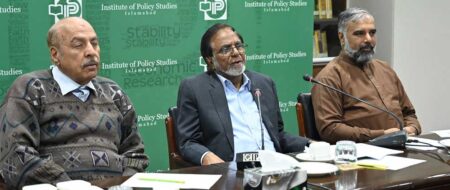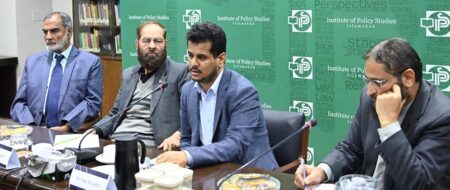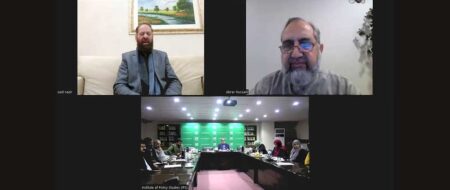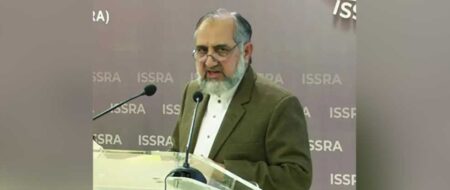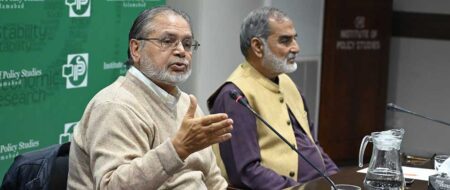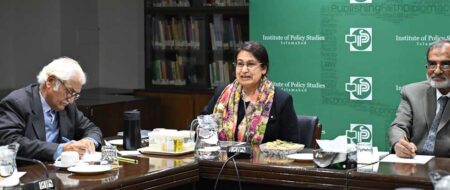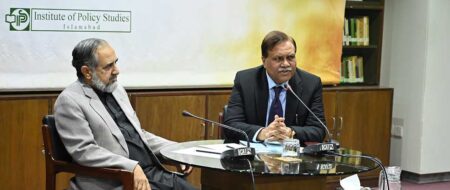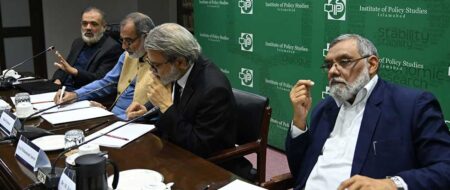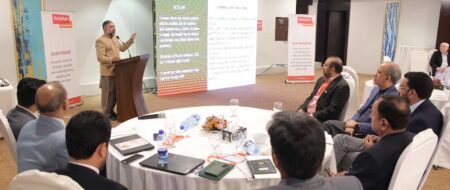Challenges to Pakistan’s Nuclear Program and FMCT
Institute of Policy Studies (IPS) Islamabad held a seminar titled “Challenges to Pakistan’s Nuclear Program & FMCT” on January 19, 2012. The speakers included: Ambassador (r) Tariq Osman Hyder, Lt. Gen (r) Asad Durrani, former DG ISI and Dr. Zafar Nawaz Jaspal
Institute of Policy Studies (IPS) Islamabad held a seminar titled “Challenges to Pakistan’s Nuclear Program & FMCT” on January 19, 2012. The speakers included: Ambassador (r) Tariq Osman Hyder, Lt. Gen (r) Asad Durrani, former DG ISI and Dr. Zafar Nawaz Jaspal, Associate Professor at Department of International Relations, Quaid-i-Azam University, Islamabad. Under the Chairmanship of Senator Prof. Khurshid Ahmad, the eminent speakers addressed this subject before a sizeable, well informed and representational audience which also participated through a question and answer segment.

The conclusions and recommendations of the seminars were as follows:
1.Pakistan’s nuclear program is a vital element of Pakistan’s national security.
2.Pakistan is a responsible nuclear state with a command, control and security system second to none, along with strong strategic export controls, all subject to internal monitoring, review and improvement if required. The safety and security of Pakistan’s nuclear program and assets, from any internal or external threat, are beyond doubt.
3.Pakistan participates in many UN, IAEA activities and international initiatives concerned with nuclear safety and security as well as non-proliferation which further demonstrates its commitment and ability
4.Some critical international perceptions are motivated, while others are due to misperceptions. Through engagement it should be attempted to correct these misperceptions.
5.The civil power generation nuclear program, in which all the civil power reactors are under IAEA safeguards, is essential to Pakistan’s energy security as a fossil fuel deficit country dependent on energy imports for its socio-economic development.
6.The power generation component of the program must be advanced to meet Pakistan’s growing energy requirements. As this civil nuclear power generation program is based on IAEA safeguarded reactors, it should not be subject to any external discriminatory technology denial policies.
7.In view of Pakistan’s experience and expertise in the safe operation of nuclear reactors and facilities, establishment of the requisite infrastructure and regulatory regimes, component manufacturing, nuclear safety as well as export controls, Pakistan is well placed for international partnerships in the peaceful uses of nuclear energy. In this regard Pakistan should explore avenues of cooperation with other countries planning their safeguarded civil nuclear programs.
8.Under the PAEC Pakistan has long standing academic and training programs as well as medical and agricultural nuclear research and treatment centers and facilities.
9.Peaceful uses cooperation with other countries for their civil nuclear programs and for agricultural and medical, research and treatment can also be explored under IAEA and OIC auspices.
10.Pakistan’s strategic nuclear program based on credible minimum nuclear deterrence is essential to maintain peace and security in this region. It is not aimed at any country and is purely defensive and to deter any aggression or adventurism. Minimum deterrence is not static, and without entering into an arms race, has to evolve to meet and to counter emerging threats to Pakistan’s security.
11.It is unfortunate that rather than discussing and partnering Pakistan’s long standing offer of a Strategic Restraint Regime (SSR) in South Asia based on nuclear restraint, conventional balance and dispute resolution, India has moved in the other direction in terms of it’s strategic capabilities, conventional build up and aggressive doctrines.
12.It is also unfortunate that many members of the international community rather than supporting strategic restraint in South Asia have bolstered India’s strategic and conventional capabilities and assets. The US-India nuclear deal and the exemption by the NSG without placing all of India’s power reactors, ambitious breeder reactors program and sizeable fissile material stocks from these power reactors under safeguards, is a clear violation of these countries NPT obligations.
13.The provision by Russia to India of nuclear submarines in the past, without any safeguards on their reactors, and now nuclear attack submarines capable of carrying nuclear armed ballistic missiles, constitute violations of Russia’s NPT obligations. Russian cooperation in the production of the Brahmos cruise missile is also a violation of Russia’s MTCR obligations.
14.Under the Indo-US nuclear deal, 8 Indian heavy water, natural uranium reactors, which are ideal for weapons grade Pu production have been left outside safeguards. Their joint capacity of 2,000 MW, running at 60% capacity, is adequate to produce 1,200 kg of weapons grade Pu which can produce 240 nuclear weapons annually. There is no precedent of keeping power reactors outside IAEA safeguards.
15.India’s ambitious breeder reactor program significantly and exponentially adds to its weapons grade Pu capability. As the objective of breeder reactors is to extend the use of fissile material for power production there is no justification for keeping this program outside of IAEA safeguards.
16.The Indian Prime Minister has stated in Parliament that no facet of India’s nuclear program which has a strategic significance would be placed under safeguards. This statement makes it clear that important aspects of India’s nuclear program kept out of safeguards have strategic objectives and therefore implications for the region and beyond.
17.The International Panel on Fissile Materials has stated inter alia in its 2010 publication, “Reducing and Eliminating Nuclear Weapons: Country Perspectives on the Challenges to Nuclear Disarmament”, that, “India’s current stockpile of weapon grade plutonium is estimated as 700 kg by the IPFM, sufficient for about 140 fission weapons, and 6.8 tons of reactor-grade plutonium, sufficient for about 850 fission weapons”.
18.While not widely known, reactor grade Pu can be used for nuclear weapons. Furthermore, a significant proportion of this unsafeguarded stockpile is likely to be weapons grade Pu, as predicted by an official American assessment made before 1974 when it stated that from the 2 reactors under construction India would be able to produce some 50-60 nuclear weapons.
19.The United States of America and the NSG should have made it a condition for any exemption for India that all its power and breeder reactors and its fissile material stockpile from its power reactors should be put under safeguards before the provision of any technology, additional nuclear power plants and uranium supplies. Equal treatment should have been given for Pakistan. An opportunity to introduce strategic restraint into South Asia was missed. Rather than professed non-proliferation objectives and NPT obligations, the motivation has been to build up India’s strategic capabilities, plus commercial considerations of profit.
20.Pakistan is therefore faced with: a grave asymmetry of fissile material stocks; an aggressive Indian “Pro-active” or “Cold Start” doctrine aimed at seizing Pakistani territory; development of an Indian nuclear Triad through the introduction of ballistic missile carrying submarines; the continued induction of other new lethal weapon systems; introduction of ABMs with cooperation from the USA, Russia and Israel; and a growing differential in terms of conventional armaments and capabilities facilitated by countries who call for better relations between Pakistan and India but whose actions on the ground are not in sync.
21.These developments have significant implications for Pakistan’s security.
22.The Seminar expressed full support for Pakistan’s position at multilateral disarmament fora, and for its principled position in the Conference on Disarmament which must be maintained.
23.In the CD Pakistan must continue to insist that:
- Only a Fissile Material Treaty (FMT) which addresses existing fissile material stocks and asymmetries to assure equal security for all should be negotiated. That would be a true disarmament objective and achievement, not an FMCT aimed at the expense of only Pakistan, the last entrant, which was forced by the Indian nuclear tests and subsequent threats, to go nuclear to preserve the strategic balance essential for peace and security in South Asia.
- That this should be in the context of parallel negotiations of equal status with the same objective to reach legal instruments on the other three core issues before the CD, Nuclear Disarmament, Negative Security Guarantees, and the Prevention of an Arms Race in Outer Space.
- The Group of 21 in its statement of 11th August 2011 at the CD Plenary, which demonstrated that Pakistan is not isolated in the CD, inter alia called for; consensus on a comprehensive and balanced program of work taking into account the security concerns of all states; the early commencement of negotiations, within the CD, on a phased program for the complete elimination of nuclear weapons within a specific period of time including a Nuclear Weapons Convention to prohibit the possession, development, stockpiling, transfer and use of nuclear weapons, leading to their ultimate destruction.
- Such a Convention goes far beyond any status quo FMCT proposal and the NPT nuclear powers to fulfill their NPT vertical deproliferation obligations should agree to demonstrate their sincerity.
24.Pakistan, a responsible nuclear State, supports the objectives of non-proliferation and should continue to contribute to the strengthening and further development of the international non-proliferation regime based on the principles of non-discrimination, equal and undiminished security for all states, and equal access to peaceful uses of nuclear energy.



